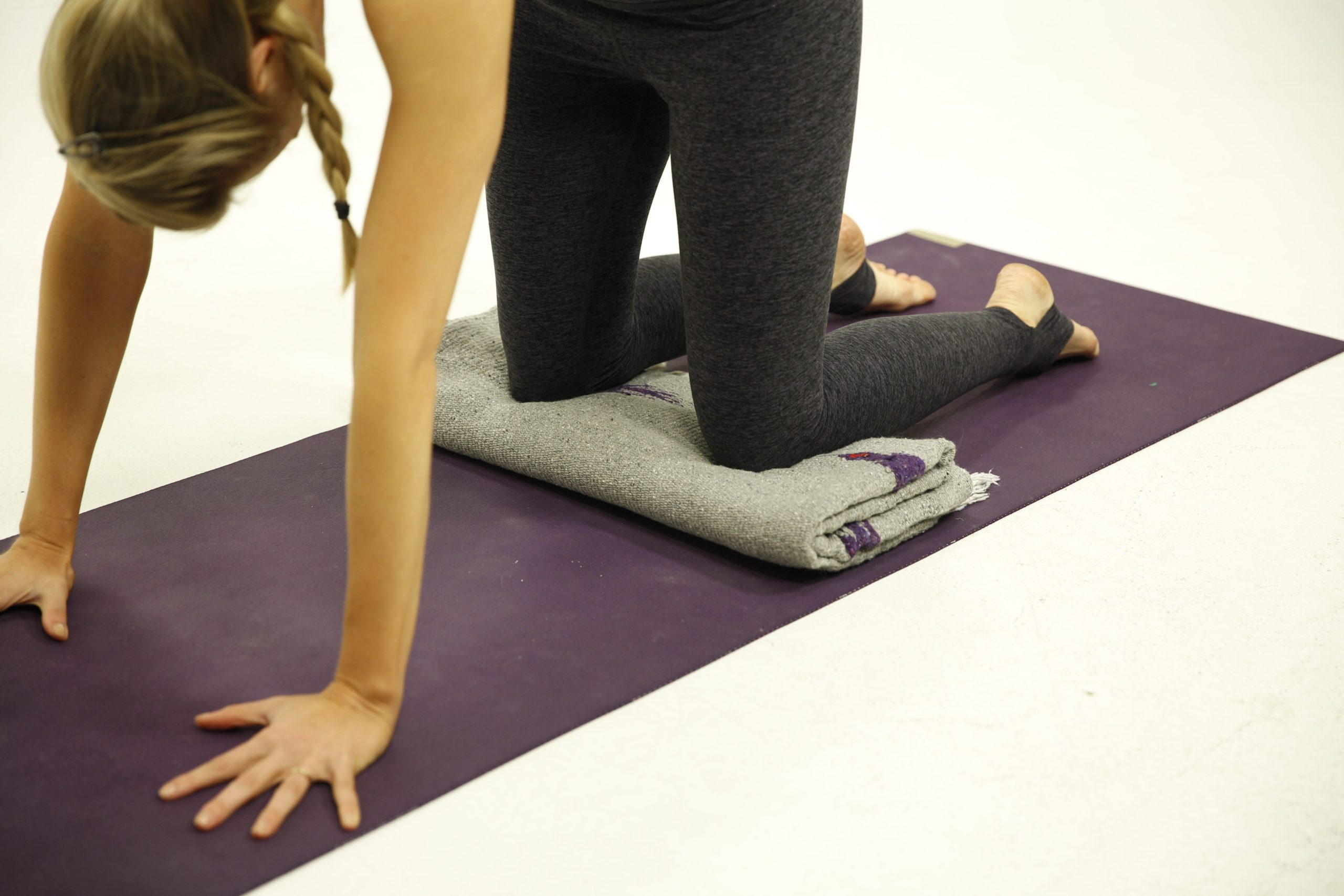
You are sooo ready for your upcoming YTT, but there’s just one thing…you’re injured and having second thoughts. Can I do a YTT if I have an injury? Cue the internal struggle:
😆 You really want to do YTT!
🤕 But you’re bandaged/stiff/sore/immobile/hospitalized!
🥺 But…YTT!
Can I Do A YTT If I Have an Injury?
You don’t want to push yourself too much or burden the teacher to accommodate your situation, but you don’t want to put your life on hold either. Maybe you’ve even paid a deposit for the training and are weighing the costs and benefits of completing the training while injured. If this is you, here are nine things to do before your try.
1. Practice ahimsa.
The principle of ahimsa (non-violence) is a good place to start. As stated in the Eight Limbs of Yoga by Patanjali, one should practice yoga without causing harm to self or others – whether that is physically, mentally, or emotionally.
Ask yourself what your limits are and how you’re going to support yourself during class. Yoga is an opportunity to create strong self awareness in order to free yourself from suffering. If you do have an injury, keep in mind that your own practice might look and feel a little different for a while. Be kind to yourself and remember that your injury, most likely, won’t last forever.
2. Talk with your doctor.
If in doubt, seek advice from the experts. It often is the not-knowing that leaves us worrying so much more and asking questions. Getting a certified opinion on where your body is at and what to expect while healing can bring great relief.
Some physical therapists or holistic health coaches might also be able to help you prepare for your yoga teacher training course by recommending certain exercises for your to incorporate into your practice, what types of movement to avoid, changes in your diet to help you recover, and medicine or supplements you might want to bring with you.
With very severe injuries, your doctor could be the one telling you clearly that right now is not a good moment to do a YTT. If that’s the case, no need to fret! The decision, at least, has been made for you!
3. Study modifications before your YTT.
Depending on the severity of your injury, it can be helpful to learn about appropriate modifications for certain postures before heading into your training.
For example, in case of lower back injury, you could replace certain poses such as forward folds with supported bridge pose variations in order to gently strengthen the muscles around your lower back. With a knee injury, however, you might want to focus a bit more on gathering an arsenal of props to avoid excess pressure in asanas like cat/cow – a pile of blankets or even knee pads aren’t a bad idea! Hip pain is a bit trickier to modify for during a full-on class since we use our hips for like, every pose. In this case, you might do best to practice a therapeutic sequence that reduces hip pain to see how your body responds, before putting yourself through a YTT.

By prepping in advance, you’ll be able to follow along with the flow of class without FOMO. Here are some other pro tips for how to modify the most common yoga poses. In addition, ask around in your yoga community for people who have had similar injuries and would be open to sharing their own experience and tips for practicing throughout the healing process.
Discover more: Yoga Pose Directory
4. Do your research on yoga insurance.
No matter how much you prepare for your YTT, sometimes things don’t work out the way we want them to. If anything goes wrong, it is always a good idea to have some sort of insurance, just in case!
Insurance can also come in handy when you are instructing other students in your yoga teacher training course who might hurt themselves (god forbid!!). Accidents do happen though, as you know!
5. Read the fine print when you sign a liability waiver.
Your yoga school most likely will ask you to sign a waiver form prior to attending their training or classes. This is to make each student responsible for themselves in case of injury, and release the studio and teachers from liability.
A good waiver form should give you valuable information on when not to attend a class/teacher training course if you are already injured, since this increases the risk for the studio, and what your responsibility is if you do choose to partake. This is a great reminder that you are in charge of your own body and should practice according to your capability and discretion.
6. Keep an open mind.
Injuries can throw us off balance. Our movement patterns shift, and suddenly, our body might feel sore from the simplest activities. If you do choose to head into a teacher training with an injury, be kind to yourself and always approach unfamiliar sensations with a sense of curiosity. After all, physical recovery is only part of the story. Mental recovery post-injury is just as important!
Having an injury could teach you a lesson or two about life you otherwise would never have had the opportunity to learn. If you cannot do a pose the way you usually would, allow yourself to explore variations or practice your skill of observing instead. Nothing in your yoga journey is a missed opportunity if you can switch your perspective and bring awareness to the messages your body is sending you.
Fall in love with my 200-Hour teacher training or …
Experience 3 Training Videos from Inside My 200-Hour Online YTT

7. YTT is not just about asana.

You probably already know some of what to expect from your YTT, and have figured out that it’s not just about the physical poses. There is SO much more you will learn!
Even though your physical practice might be unpredictable when your body is in the process of recovery, there will be many other areas of study you can count on immersing yourself in, whether that’s philosophy, anatomy, teaching techniques, or mentorship. You might even choose a YTT that has a strong focus on meditation and breathing techniques – which should be part of any balanced practice, but are especially useful for cultivating peace of mind when injured!
8. Explore your YTT options.
Nowadays, there are plenty of different ways to access yoga teacher trainings. While some are held as intensives over several weeks, there are also options to study on weekends over a longer period of time. This could be a great option if you need to rest a lot with your injury.
Shameless pitch here! My 200-hour online teacher training allows you to work through the entire course content at your own pace, from the comfort of wherever you have WiFi.
Read more about exploring your YTT options:
- The 3 Archetypes: Yoga Personality Types & Choosing A YTT
- Uplifted Yoga Teacher Training vs Akasha Yoga Academy
- Uplifted vs Ithaca Farm: Which YTT Is Right For You?
- Uplifted Yoga Teacher Training vs Drishti Beats
- Uplifted Yoga Teacher Training vs Siddhi Yoga
Take my quiz to find out which YTT is best for you:
9. Know your “Why”.
Why are you taking this training? And – why now?
If you want to become a yoga instructor, an injury is a chance to take your yoga practice and teaching to a whole new level. Healing is a transformative process by nature and will teach you soooo much about self-acceptance if you’re patient. You’ll also learn some coping strategies and tools to practice yoga with an injury, which are super useful skills to offer the world! Be honest with yourself, be loving, and you’ll be sure to make the best decision about YTT this time around!
Next Steps
- Check out my YouTube channel and find some yoga classes that you can try out for yourself!
- Explore my knowledge hub for How to Become a Yoga Teacher
- Attend a 200 YTT info session to see what else you’ll learn in my online teacher training.
Experience 3 Training Videos from Inside My 200-Hour Online YTT

YOU MIGHT ALSO LIKE
- What is Yoga Alliance and Do I Need an RYT Certificate to Teach Yoga?
- 200 Hour Yoga Teacher Training: What To Expect, How To Prepare, Where To Do It
- Is An Online Yoga Teacher Training Worth The Investment?
- Levels of Yoga Certification: What’s The Difference Between 200-, 300-, and 500-Hour YTT Courses?yoga certification
- What Does A 500 HR Yoga Teacher Training Course Cover? Standards and Benefits
- A Guide to The Best Yin Yoga Teacher Training Programs
- Hatha Yoga Teacher Training Certification: Immersion, Online, or in Studio?
- Wanna Teach Kids Yoga? Find A Fun Childrens Yoga Teacher Training!
- Ashtanga Yoga Teacher Certification: Where And How To Get It
- How To Know If An Online YTT Is Legit: 8 Things To Look For
- Want to Become a Certified Vinyasa Yoga Teacher? Read This.
- How to Choose a Yoga Teacher Training (That Won’t Rip You Off)










